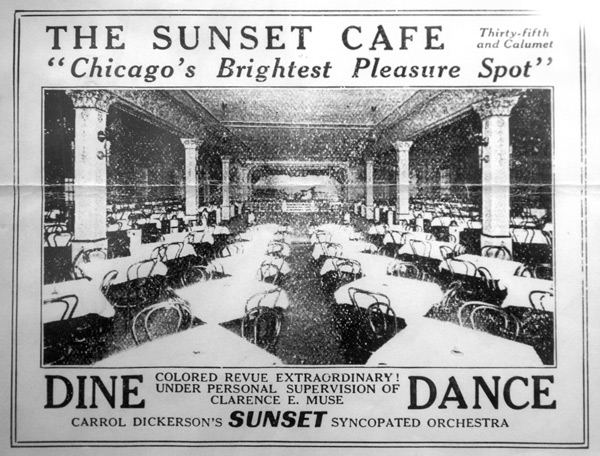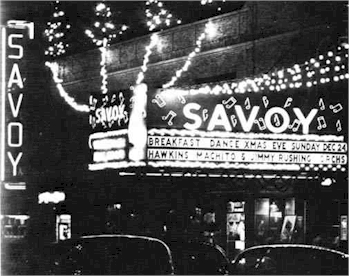Text by Floyd Levin
Throughout the history of jazz the venues that employed musicians have played a very prominent role in the music's development. During the Jazz Age and the Swing Era, musicians, booked for lengthy engagements, were often closely identified with the sites where they performed. The barrooms, ballrooms, nightclubs, and hotels that might otherwise have been forgotten, are now recognized as prominent landmarks along jazz's journey from obscurity to world-wide acclaim. The tunes selected for this week's show highlight several of those landmarks and the musicians who recorded tune titles that perpetuated the memory of these historic locations.
There are over two thousand venues listed in The New Grove Dictionary of Jazz, 2nd Edition, so our show this week barely scratches the surface.

Recording of "Apex Blues" by Jimmie Noone & His Orchestra, 1929. Courtesy Red Hot Jazz Archive.
The Apex Club, a South Side Chicago venue, was a deluxe supper club where New Orleans clarinetist Jimmy Noone led a small band from 1926 to 1928. Noone's Apex Club Orchestra included pianist Earl Hines. Their classic series of Vocalion recordings, among them "Apex Blues," will always be considered prime examples of swinging New Orleans jazz.
Situated at the center of Chicago nightlife in the '20s, the Sunset Cafe was a very popular "black and tan" club. Like most nightclubs in the Prohibition years, it was controlled by Al Capone's gangster syndicate. The Sunset Cafe developed as a memorable jazz venue when Carroll Dickerson became the resident leader in the mid-'20s. His band, which included young Louis Armstrong and pianist Earl Hines, was extremely successful and attracted large crowds to their nightly floor show. When Dickerson left the club, Louis Armstrong remained and formed his Sunset Cafe Stompers.

Ad for the famous Sunset Café. Image courtesy the Earl Hines and Stanley Dance Collection.
Armstrong soon became the leading jazz artist in Chicago. On November 16, 1926, he led his recording band, the Louis Armstrong Hot Five, during a session for Okeh Records that included his acclaimed recording "Sunset Cafe Stomp." The tune was not recorded again for 15 years until Lu Watters' Yerba Buena Jazz Band revived the number on their Jazz Man release.
"West End Blues" was named after West End, the New Orleans resort area on Lake Ponchartrain. It was a 15 cent ride on old Smoky Mary, the train that carried revelers to enjoy the music played by Kid Ory, Oscar Celestin, the New Orleans Owls, and the Silverleaf Orchestra at the West End Roof Garden. Without question, Louis Armstrong's performance on his 1928 recording of "West End Blues," often considered his best effort, ranks among the finest of all jazz recordings. Fans and musicians are still dazzled when they listen to Armstrong's great recording made with just a six-piece band, 75 years ago. The simple blues, a composition of Louis' mentor, Joe Oliver, opens with a long flamboyant cadenza that still intimidates trumpet and cornet players.

Sheet music for "Maple Leaf Rag." Image courtesy wikimedia.
Ragtime music was a vital component to jazz's roots. Scott Joplin was entertaining at the Maple Leaf Club, a small men's social club in Sedalia, Missouri, when he composed the excellent "Maple Leaf Rag." This was not the first rag published; over a hundred had already appeared when this song entered the scene in 1899, but it rapidly became the definitive melody of the Ragtime Era. It was the first American composition to sell a million copies, and the most recorded rag.
Over the years, the career of composer-arranger-pianist Jelly Roll Morton has been carefully documented. We have learned that he wrote a pair of important compositions on the West Coast during the early 20s. An article in the Los Angeles Defender announced that Morton had obtained a visa to work in Tijuana, Mexico. One of the tunes he wrote while working in there in 1921 was "Kansas City Stomp," named after the Kansas City Bar where he was playing.
The second number written by Morton while in Tijuana is one of his most beautiful and dynamic compositions, "The Pearls." He dedicated it to Pearl, a pretty Mexican barmaid at the Kansas City Bar. He described this song as "consisting of several sections, each matching the other, and contributing to the total effect of a beautiful pearl necklace." During Morton's original piano solo recording of "The Pearls" in 1923, he anticipated every musical punctuation and instrumental solo that he later recorded with his Red Hot Peppers four years later.
(1).jpg)
The Landing, San Antonio.
"Riverwalk Blues" was improvised "on the spot" by piano soloist Dick Hyman and commemorates the broadcast site of our weekly program. In 1963, The Landing's original location was in a warehouse basement along the undeveloped San Antonio River area that evolved into the city's now acclaimed Riverwalk. This was where young Jim Cullum, Jr. and his clarinetist father Jim Cullum, Sr. launched their Happy Jazz Band, now known as the Jim Cullum Jazz Band. The Landing, located now in the luxurious Hyatt Regency Hotel, is a key element on the rejuvenated Riverwalk. In continuous operation for 40 years, it has functioned longer than the accumulated duration of all the historical venues discussed on our program this week.
The beautiful ballad "Rose Room" was written in 1917 by band leader Art Hickman and named after the beautiful Rose Room in the St. Francis Hotel in San Francisco during his orchestra's lengthy residency. The Panama-Pacific International Exposition attracted thousands of tourists to the city, and, as a result, Hickman probably became the first dance band leader to receive national attention.
The Savoy Ballroom, known as the "Home of Happy Feet," covered an entire block in New York's Harlem and was advertised as "the world's most beautiful ballroom." It opened in 1926 and quickly became the city's number one dance palace. The tune, "Stompin' At The Savoy," one of the top songs of the Swing Era, was introduced in the mid-'30s by bandleader Chick Webb while he was a featured attraction at the Savoy with his young vocalist, Ella Fitzgerald. Benny Goodman's 1935 recording of the number was one of his first major hits.

William "Count" Basie. Image courtesy sheet music direct.com.
The great bandleader Count Basie was keenly aware that his music was primarily for dancing, and its vital element was swing. Basie knew that, if it did not swing, it was not danceable--and he led one of the most toe-tapping and finger-snapping bands in the country.
Basie's hit 1939 recording of "Jumpin' At The Woodside," using riffs as structural devices, was supported by his world-famous rhythm section. It ranks among the Swing Era's prominent recordings, and helped set the standards for the Big Band Era. Basie named the tune after the Woodside Hotel, a popular all-night jam session spot for New York musicians during the '30s. It gained prestige following the release of the Count Basie recording.
Photo credit for home page teaser image: Louis Armstrong's recording of Sunset Cafe Stomp. Photo courtesy wn.com.
Floyd Levin is the author of many books on jazz including his highly acclaimed Classic Jazz--A Personal View of the Music and the Musicians, published in 2000 by the University of California Press in Berkeley, California (also released in paperback).


